Table of Contents
- Vostro 3405 Service Manual
- Contents
- Working on your computer
- Exploded View
- Disassembly and reassembly
- Troubleshooting
- Handling swollen Lithium-ion batteries
- Dell SupportAssist Pre-boot System Performance Check diagnostics
- System diagnostic lights
- Real-Time Clock (RTC Reset)
- Updating the BIOS in Windows
- Updating the BIOS using the USB drive in Windows
- Backup media and recovery options
- WiFi power cycle
- Drain residual flea power (perform hard reset)
- Getting help and contacting Dell
DELL 3405 User Manual
Displayed below is the user manual for 3405 by DELL which is a product in the Notebooks category. This manual has pages.
Related Manuals

Vostro 3405
Service Manual
Regulatory Model: P132G
Regulatory Type: P132G002
August 2021
Rev. A02

Notes, cautions, and warnings
NOTE: A NOTE indicates important information that helps you make better use of your product.
CAUTION: A CAUTION indicates either potential damage to hardware or loss of data and tells you how to avoid
the problem.
WARNING: A WARNING indicates a potential for property damage, personal injury, or death.
© 2020 Dell Inc. or its subsidiaries. All rights reserved. Dell, EMC, and other trademarks are trademarks of Dell Inc. or its subsidiaries. Other
trademarks may be trademarks of their respective owners.

Notes, cautions, and warnings
NOTE: A NOTE indicates important information that helps you make better use of your product.
CAUTION: A CAUTION indicates either potential damage to hardware or loss of data and tells you how to avoid
the problem.
WARNING: A WARNING indicates a potential for property damage, personal injury, or death.
© 2020 Dell Inc. or its subsidiaries. All rights reserved. Dell, EMC, and other trademarks are trademarks of Dell Inc. or its subsidiaries.
Other trademarks may be trademarks of their respective owners.

Chapter 1: Working on your computer........................................................................................... 6
Safety instructions.............................................................................................................................................................. 6
Working inside your computer.................................................................................................................................... 6
Safety precautions........................................................................................................................................................ 9
After working inside your computer..........................................................................................................................9
Chapter 2: Exploded View............................................................................................................ 10
Chapter 3: Disassembly and reassembly.......................................................................................13
Secure Digital Card............................................................................................................................................................ 13
Removing the Secure Digital card............................................................................................................................13
Installing the Secure Digital card.............................................................................................................................. 14
Base cover........................................................................................................................................................................... 15
Removing the base cover...........................................................................................................................................15
Installing the base cover.............................................................................................................................................18
Battery................................................................................................................................................................................. 20
Lithium-ion battery precautions...............................................................................................................................20
Removing the battery................................................................................................................................................. 21
Installing the battery...................................................................................................................................................22
Solid-state drive................................................................................................................................................................ 23
Removing the M.2 2230 solid-state drive............................................................................................................. 23
Installing the M.2 2230 solid-state drive............................................................................................................... 24
Removing the M.2 2280 solid-state drive............................................................................................................. 25
Installing the M.2 2280 solid-state drive............................................................................................................... 26
Wireless card...................................................................................................................................................................... 27
Removing the wireless card...................................................................................................................................... 27
Installing the wireless card........................................................................................................................................ 28
I/O board.............................................................................................................................................................................29
Removing the I/O board............................................................................................................................................ 29
Installing the IO board................................................................................................................................................ 30
Coin-cell battery.................................................................................................................................................................31
Removing the coin-cell battery.................................................................................................................................31
Installing the coin-cell battery...................................................................................................................................31
Hard drive............................................................................................................................................................................32
Removing the hard drive........................................................................................................................................... 32
Installing the hard drive..............................................................................................................................................33
Memory modules............................................................................................................................................................... 35
Removing the memory modules...............................................................................................................................35
Installing the memory modules.................................................................................................................................35
Speakers.............................................................................................................................................................................. 36
Removing the speakers..............................................................................................................................................36
Installing the speakers................................................................................................................................................ 37
Heat sink..............................................................................................................................................................................38
Removing the heat sink............................................................................................................................................. 38
Contents
4 Contents

Installing the heat sink................................................................................................................................................39
Fan........................................................................................................................................................................................ 40
Removing the fan........................................................................................................................................................ 40
Installing the fan........................................................................................................................................................... 41
Power button..................................................................................................................................................................... 42
Removing the power-button with optional fingerprint reader......................................................................... 42
Installing the power button....................................................................................................................................... 43
Display assembly................................................................................................................................................................44
Removing the display assembly............................................................................................................................... 44
Installing the display assembly..................................................................................................................................46
Display bezel....................................................................................................................................................................... 47
Removing the display bezel.......................................................................................................................................47
Installing the display bezel ........................................................................................................................................49
Display panel.......................................................................................................................................................................50
Removing the display panel...................................................................................................................................... 50
Installing the display panel.........................................................................................................................................52
Camera.................................................................................................................................................................................55
Removing the camera module..................................................................................................................................55
Installing the camera module.................................................................................................................................... 56
Touchpad.............................................................................................................................................................................57
Removing the touchpad.............................................................................................................................................57
Installing the touchpad...............................................................................................................................................58
System board..................................................................................................................................................................... 60
Removing the system board..................................................................................................................................... 60
Installing the system board....................................................................................................................................... 62
Power-adapter port..........................................................................................................................................................65
Removing the power-adapter port......................................................................................................................... 65
Installing the power-adapter port............................................................................................................................66
Palm-rest and keyboard assembly.................................................................................................................................67
Removing the palm-rest and keyboard assembly................................................................................................ 67
Installing the palm-rest and keyboard assembly.................................................................................................. 68
Chapter 4: Troubleshooting......................................................................................................... 69
Handling swollen Lithium-ion batteries........................................................................................................................ 69
Dell SupportAssist Pre-boot System Performance Check diagnostics................................................................70
Running the SupportAssist Pre-Boot System Performance Check................................................................70
System diagnostic lights.................................................................................................................................................. 70
Real-Time Clock (RTC Reset).........................................................................................................................................71
Updating the BIOS in Windows...................................................................................................................................... 72
Updating the BIOS using the USB drive in Windows................................................................................................72
Backup media and recovery options............................................................................................................................. 72
WiFi power cycle................................................................................................................................................................72
Drain residual flea power (perform hard reset)......................................................................................................... 73
Chapter 5: Getting help and contacting Dell................................................................................ 74
Contents 5

Working on your computer
Topics:
•Safety instructions
Safety instructions
Prerequisites
Use the following safety guidelines to protect your computer from potential damage and to ensure your personal safety. Unless
otherwise noted, each procedure included in this document assumes that the following conditions exist:
●You have read the safety information that shipped with your computer.
●A component can be replaced or, if purchased separately, installed by performing the removal procedure in reverse order.
About this task
NOTE: Disconnect all power sources before opening the computer cover or panels. After you finish working inside the
computer, replace all covers, panels, and screws before connecting to the power source.
WARNING: Before working inside your computer, read the safety information that shipped with your computer.
For additional safety best practices information, see the Regulatory Compliance Homepage
CAUTION: Many repairs may only be done by a certified service technician. You should only perform
troubleshooting and simple repairs as authorized in your product documentation, or as directed by the online or
telephone service and support team. Damage due to servicing that is not authorized by Dell is not covered by
your warranty. Read and follow the safety instructions that came with the product.
CAUTION: To avoid electrostatic discharge, ground yourself by using a wrist grounding strap or by periodically
touching an unpainted metal surface at the same time as touching a connector on the back of the computer.
CAUTION: Handle components and cards with care. Do not touch the components or contacts on a card. Hold a
card by its edges or by its metal mounting bracket. Hold a component such as a processor by its edges, not by
its pins.
CAUTION: When you disconnect a cable, pull on its connector or on its pull-tab, not on the cable itself. Some
cables have connectors with locking tabs; if you are disconnecting this type of cable, press in on the locking
tabs before you disconnect the cable. As you pull connectors apart, keep them evenly aligned to avoid bending
any connector pins. Also, before you connect a cable, ensure that both connectors are correctly oriented and
aligned.
NOTE: The color of your computer and certain components may appear differently than shown in this document.
Working inside your computer
Before working inside your computer
About this task
NOTE: The images in this document may differ from your computer depending on the configuration you ordered.
1
6 Working on your computer

Steps
1. Save and close all open files and exit all open applications.
2. Shut down your computer. Click Start > Power > Shut down.
NOTE: If you are using a different operating system, see the documentation of your operating system for shut-down
instructions.
3. Disconnect your computer and all attached devices from their electrical outlets.
4. Disconnect all attached network devices and peripherals, such as keyboard, mouse, and monitor from your computer.
CAUTION: To disconnect a network cable, first unplug the cable from your computer and then unplug the
cable from the network device.
5. Remove any media card and optical disc from your computer, if applicable.
Electrostatic discharge—ESD protection
ESD is a major concern when you handle electronic components, especially sensitive components such as expansion cards,
processors, memory DIMMs, and system boards. Very slight charges can damage circuits in ways that may not be obvious, such
as intermittent problems or a shortened product life span. As the industry pushes for lower power requirements and increased
density, ESD protection is an increasing concern.
Due to the increased density of semiconductors used in recent Dell products, the sensitivity to static damage is now higher than
in previous Dell products. For this reason, some previously approved methods of handling parts are no longer applicable.
Two recognized types of ESD damage are catastrophic and intermittent failures.
●Catastrophic – Catastrophic failures represent approximately 20 percent of ESD-related failures. The damage causes
an immediate and complete loss of device functionality. An example of catastrophic failure is a memory DIMM that has
received a static shock and immediately generates a "No POST/No Video" symptom with a beep code emitted for missing or
nonfunctional memory.
●Intermittent – Intermittent failures represent approximately 80 percent of ESD-related failures. The high rate of
intermittent failures means that most of the time when damage occurs, it is not immediately recognizable. The DIMM
receives a static shock, but the tracing is merely weakened and does not immediately produce outward symptoms related to
the damage. The weakened trace may take weeks or months to melt, and in the meantime may cause degradation of memory
integrity, intermittent memory errors, etc.
The more difficult type of damage to recognize and troubleshoot is the intermittent (also called latent or "walking wounded")
failure.
Perform the following steps to prevent ESD damage:
●Use a wired ESD wrist strap that is properly grounded. The use of wireless anti-static straps is no longer allowed; they do not
provide adequate protection. Touching the chassis before handling parts does not ensure adequate ESD protection on parts
with increased sensitivity to ESD damage.
●Handle all static-sensitive components in a static-safe area. If possible, use anti-static floor pads and workbench pads.
●When unpacking a static-sensitive component from its shipping carton, do not remove the component from the anti-static
packing material until you are ready to install the component. Before unwrapping the anti-static packaging, ensure that you
discharge static electricity from your body.
●Before transporting a static-sensitive component, place it in an anti-static container or packaging.
ESD field service kit
The unmonitored Field Service kit is the most commonly used service kit. Each Field Service kit includes three main components:
anti-static mat, wrist strap, and bonding wire.
Components of an ESD field service kit
The components of an ESD field service kit are:
●Anti-Static Mat – The anti-static mat is dissipative and parts can be placed on it during service procedures. When using an
anti-static mat, your wrist strap should be snug and the bonding wire should be connected to the mat and to any bare metal
on the system being worked on. Once deployed properly, service parts can be removed from the ESD bag and placed directly
on the mat. ESD-sensitive items are safe in your hand, on the ESD mat, in the system, or inside a bag.
Working on your computer 7

●Wrist Strap and Bonding Wire – The wrist strap and bonding wire can be either directly connected between your wrist
and bare metal on the hardware if the ESD mat is not required, or connected to the anti-static mat to protect hardware that
is temporarily placed on the mat. The physical connection of the wrist strap and bonding wire between your skin, the ESD
mat, and the hardware is known as bonding. Use only Field Service kits with a wrist strap, mat, and bonding wire. Never
use wireless wrist straps. Always be aware that the internal wires of a wrist strap are prone to damage from normal wear
and tear, and must be checked regularly with a wrist strap tester in order to avoid accidental ESD hardware damage. It is
recommended to test the wrist strap and bonding wire at least once per week.
●ESD Wrist Strap Tester – The wires inside of an ESD strap are prone to damage over time. When using an unmonitored
kit, it is a best practice to regularly test the strap prior to each service call, and at a minimum, test once per week. A
wrist strap tester is the best method for doing this test. If you do not have your own wrist strap tester, check with your
regional office to find out if they have one. To perform the test, plug the wrist-strap's bonding-wire into the tester while it is
strapped to your wrist and push the button to test. A green LED is lit if the test is successful; a red LED is lit and an alarm
sounds if the test fails.
●Insulator Elements – It is critical to keep ESD sensitive devices, such as plastic heat sink casings, away from internal parts
that are insulators and often highly charged.
●Working Environment – Before deploying the ESD Field Service kit, assess the situation at the customer location. For
example, deploying the kit for a server environment is different than for a desktop or portable environment. Servers are
typically installed in a rack within a data center; desktops or portables are typically placed on office desks or cubicles. Always
look for a large open flat work area that is free of clutter and large enough to deploy the ESD kit with additional space to
accommodate the type of system that is being repaired. The workspace should also be free of insulators that can cause an
ESD event. On the work area, insulators such as Styrofoam and other plastics should always be moved at least 12 inches or
30 centimeters away from sensitive parts before physically handling any hardware components
●ESD Packaging – All ESD-sensitive devices must be shipped and received in static-safe packaging. Metal, static-shielded
bags are preferred. However, you should always return the damaged part using the same ESD bag and packaging that the
new part arrived in. The ESD bag should be folded over and taped shut and all the same foam packing material should be
used in the original box that the new part arrived in. ESD-sensitive devices should be removed from packaging only at an
ESD-protected work surface, and parts should never be placed on top of the ESD bag because only the inside of the bag is
shielded. Always place parts in your hand, on the ESD mat, in the system, or inside an anti-static bag.
●Transporting Sensitive Components – When transporting ESD sensitive components such as replacement parts or parts
to be returned to Dell, it is critical to place these parts in anti-static bags for safe transport.
ESD protection summary
It is recommended that all field service technicians use the traditional wired ESD grounding wrist strap and protective anti-static
mat at all times when servicing Dell products. In addition, it is critical that technicians keep sensitive parts separate from all
insulator parts while performing service and that they use anti-static bags for transporting sensitive components.
Transporting sensitive components
When transporting ESD sensitive components such as replacement parts or parts to be returned to Dell, it is critical to place
these parts in anti-static bags for safe transport.
Lifting equipment
Adhere to the following guidelines when lifting heavy weight equipment:
CAUTION: Do not lift greater than 50 pounds. Always obtain additional resources or use a mechanical lifting
device.
1. Get a firm balanced footing. Keep your feet apart for a stable base, and point your toes out.
2. Tighten stomach muscles. Abdominal muscles support your spine when you lift, offsetting the force of the load.
3. Lift with your legs, not your back.
4. Keep the load close. The closer it is to your spine, the less force it exerts on your back.
5. Keep your back upright, whether lifting or setting down the load. Do not add the weight of your body to the load. Avoid
twisting your body and back.
6. Follow the same techniques in reverse to set the load down.
8Working on your computer

Safety precautions
The safety precautions chapter details the primary steps to be taken before performing any disassembly instructions.
Observe the following safety precautions before you perform any installation or break/fix procedures involving disassembly or
reassembly:
●Turn off the system and all attached peripherals.
●Disconnect the system and all attached peripherals from AC power.
●Disconnect all network cables, telephone, and telecommunications lines from the system.
●Use an ESD field service kit when working inside any to avoid electrostatic discharge (ESD) damage.
●After removing any system component, carefully place the removed component on an anti-static mat.
●Wear shoes with non-conductive rubber soles to reduce the chance of getting electrocuted.
Standby power
Dell products with standby power must be unplugged before you open the case. Systems that incorporate standby power are
essentially powered while turned off. The internal power enables the system to be remotely turned on (wake on LAN) and
suspended into a sleep mode and has other advanced power management features.
Unplugging, pressing and holding the power button for 15 seconds should discharge residual power in the system board.
Bonding
Bonding is a method for connecting two or more grounding conductors to the same electrical potential. This is done through
the use of a field service electrostatic discharge (ESD) kit. When connecting a bonding wire, ensure that it is connected to bare
metal and never to a painted or non-metal surface. The wrist strap should be secure and in full contact with your skin, and
ensure that you remove all jewelry such as watches, bracelets, or rings prior to bonding yourself and the equipment.
After working inside your computer
About this task
CAUTION: Leaving stray or loose screws inside your computer may severely damage your computer.
Steps
1. Replace all screws and ensure that no stray screws remain inside your computer.
2. Connect any external devices, peripherals, or cables you removed before working on your computer.
3. Replace any media cards, discs, or any other parts that you removed before working on your computer.
4. Connect your computer and all attached devices to their electrical outlets.
5. Turn on your computer.
Working on your computer 9

2
10 Exploded View
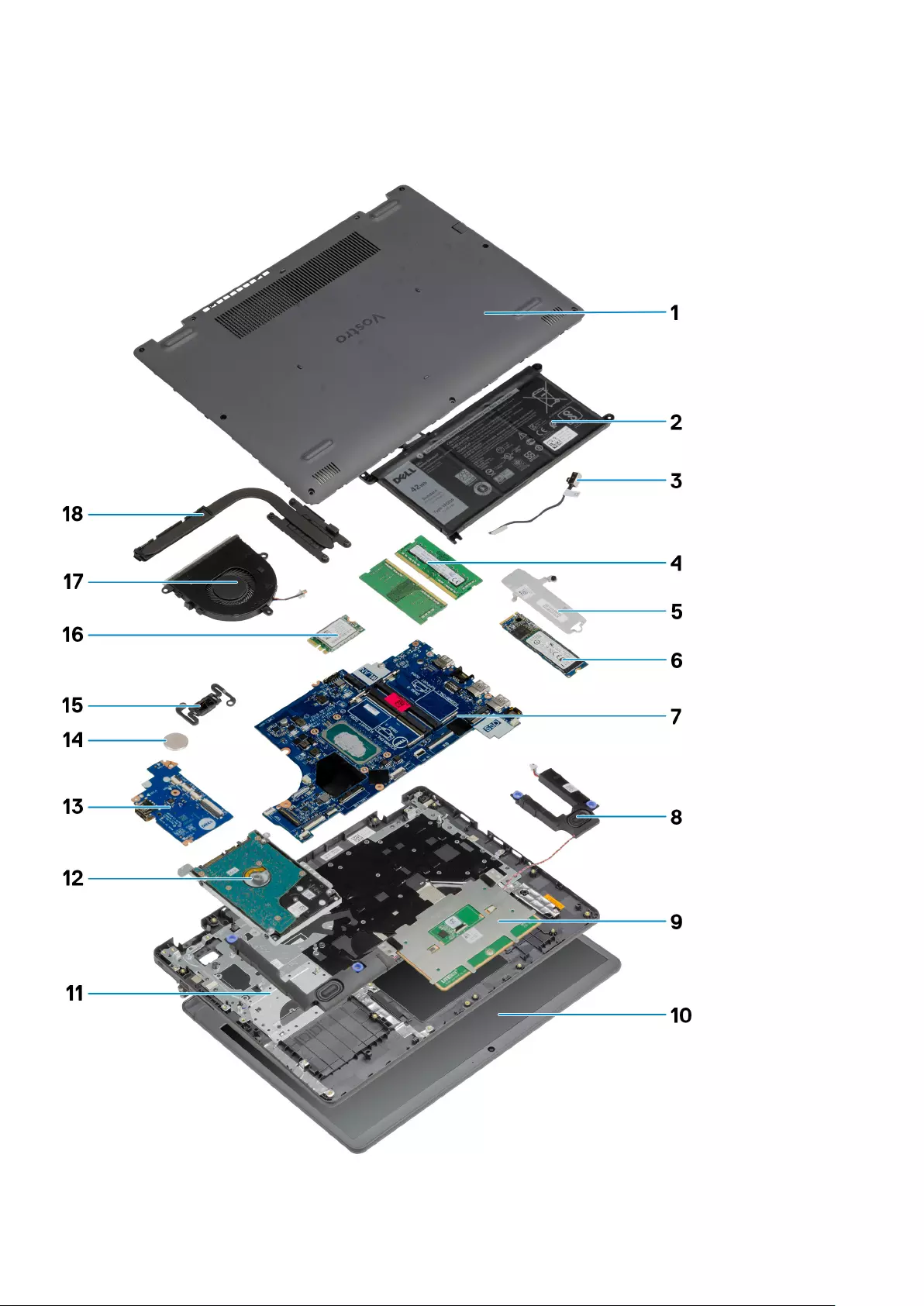
Exploded View
Exploded View 11

1. Base cover
2. Battery
3. DC-in Port
4. Memory modules
5. Solid-State Drive bracket
6. Solid-State Drive
7. System Board
8. Speakers
9. Touchpad
10. Display Assembly
11. Palmrest Assembly
12. HDD Assembly
13. IO Board
14. Coin Cell Battery
15. Power Button Module
16. WLAN Card
17. Fan Assembly
18. Heatsink assembly
NOTE: Dell provides a list of components and their part numbers for the original system configuration purchased. These
parts are available according to warranty coverages purchased by the customer. Contact your Dell sales representative for
purchase options.
12 Exploded View

Disassembly and reassembly
Topics:
•Secure Digital Card
•Base cover
•Battery
•Solid-state drive
•Wireless card
•I/O board
•Coin-cell battery
•Hard drive
•Memory modules
•Speakers
•Heat sink
•Fan
•Power button
•Display assembly
•Display bezel
•Display panel
•Camera
•Touchpad
•System board
•Power-adapter port
•Palm-rest and keyboard assembly
Secure Digital Card
Removing the Secure Digital card
Prerequisites
1. Follow the procedure in Before working inside your computer
3
Disassembly and reassembly 13

About this task
Steps
1. Push the secure digital card to release it from the computer.
2. Slide the secure digital card out of the computer.
Installing the Secure Digital card
Prerequisites
If you are replacing a component, remove the existing component before performing the installation procedure.
14 Disassembly and reassembly

About this task
Steps
Slide the secure digital into the slot until it clicks into place.
Next steps
1. Follow the procedure in after working inside your computer
Base cover
Removing the base cover
Prerequisites
1. Follow the procedure in Before working inside your computer.
2. Remove the SD card.
Disassembly and reassembly 15

About this task
NOTE: Before removing the base cover, ensure that there is no SD card installed in the SD card slot on your computer.
The following images indicate the location of the base cover and provides a visual representation of the removal procedure.
16 Disassembly and reassembly

Disassembly and reassembly 17

Steps
1. Remove the seven screws (M2.5x5) that secure the base cover to the palm-rest and keyboard assembly.
2. Loosen the two captive screws.
3. Using a plastic scribe, pry the base cover from the bottom left and continue to work on the sides to open the base cover.
4. Lift and slide the base cover off the palm-rest and keyboard assembly.
5. Disconnect the battery cable from the system board.
6. Press and hold the power button for five seconds to ground the computer and drain the flea power.
Installing the base cover
Prerequisites
If you are replacing a component, remove the existing component before performing the installation process.
About this task
The following images indicate the location of the base cover and provides a visual representation of the installation procedure.
18 Disassembly and reassembly

Disassembly and reassembly 19

Steps
1. Connect the battery cable to the connector on the system board.
2. Place and snap the base cover into place on the palm-rest and keyboard assembly.
3. Tighten the two captive screws on the base cover.
4. Replace the seven screws (M2.5x5) that secure the base cover to the palm-rest and keyboard assembly.
Next steps
1. Install the SD card.
2. Follow the procedure in After working inside your computer.
Battery
Lithium-ion battery precautions
CAUTION:
●Exercise caution when handling Lithium-ion batteries.
●Discharge the battery completely before removing it. Disconnect the AC power adapter from the system and
operate the computer solely on battery power—the battery is fully discharged when the computer no longer
turns on when the power button is pressed.
●Do not crush, drop, mutilate, or penetrate the battery with foreign objects.
●Do not expose the battery to high temperatures, or disassemble battery packs and cells.
●Do not apply pressure to the surface of the battery.
20 Disassembly and reassembly

●Do not bend the battery.
●Do not use tools of any kind to pry on or against the battery.
●Ensure any screws during the servicing of this product are not lost or misplaced, to prevent accidental
puncture or damage to the battery and other system components.
●If the battery gets stuck inside your computer as a result of swelling, do not try to release it as puncturing,
bending, or crushing a lithium-ion battery can be dangerous. In such an instance, contact Dell technical
support for assistance. See www.dell.com/contactdell.
●Always purchase genuine batteries from www.dell.com or authorized Dell partners and resellers.
●Swollen batteries should not be used and should be replaced and disposed properly. For guidelines on how to
handle and replace swollen Lithium-ion batteries, see Handling swollen Lithium-ion batteries.
Removing the battery
Prerequisites
1. Follow the procedure in Before working inside your computer.
2. Remove the SD card.
3. Remove the base cover.
About this task
The following images indicate the location of the battery and provides a visual representation of the removal procedure.
Steps
1. Disconnect the battery cable from the system board, if applicable.
2. Remove the three screws (M2x3) that secure the battery to the palm-rest and keyboard assembly.
3. Lift the battery off the palm-rest and keyboard assembly.
Disassembly and reassembly 21

Installing the battery
Prerequisites
If you are replacing a component, remove the existing component before performing the installation process.
About this task
The following images indicate the location of the battery and provides a visual representation of the installation procedure.
Steps
1. Place the battery on the palm-rest and keyboard assembly.
NOTE: When installing the battery into the system, insert the tab at the bottom left corner of the battery into the hook
on the bottom side of the palm rest.
2. Align the screw holes on the battery to the screw holes on the palm-rest and keyboard assembly.
3. Replace the three screws (M2x3) that secure the battery to the palm-rest and keyboard assembly.
4. Connect the battery cable to the connector on the system board.
22 Disassembly and reassembly
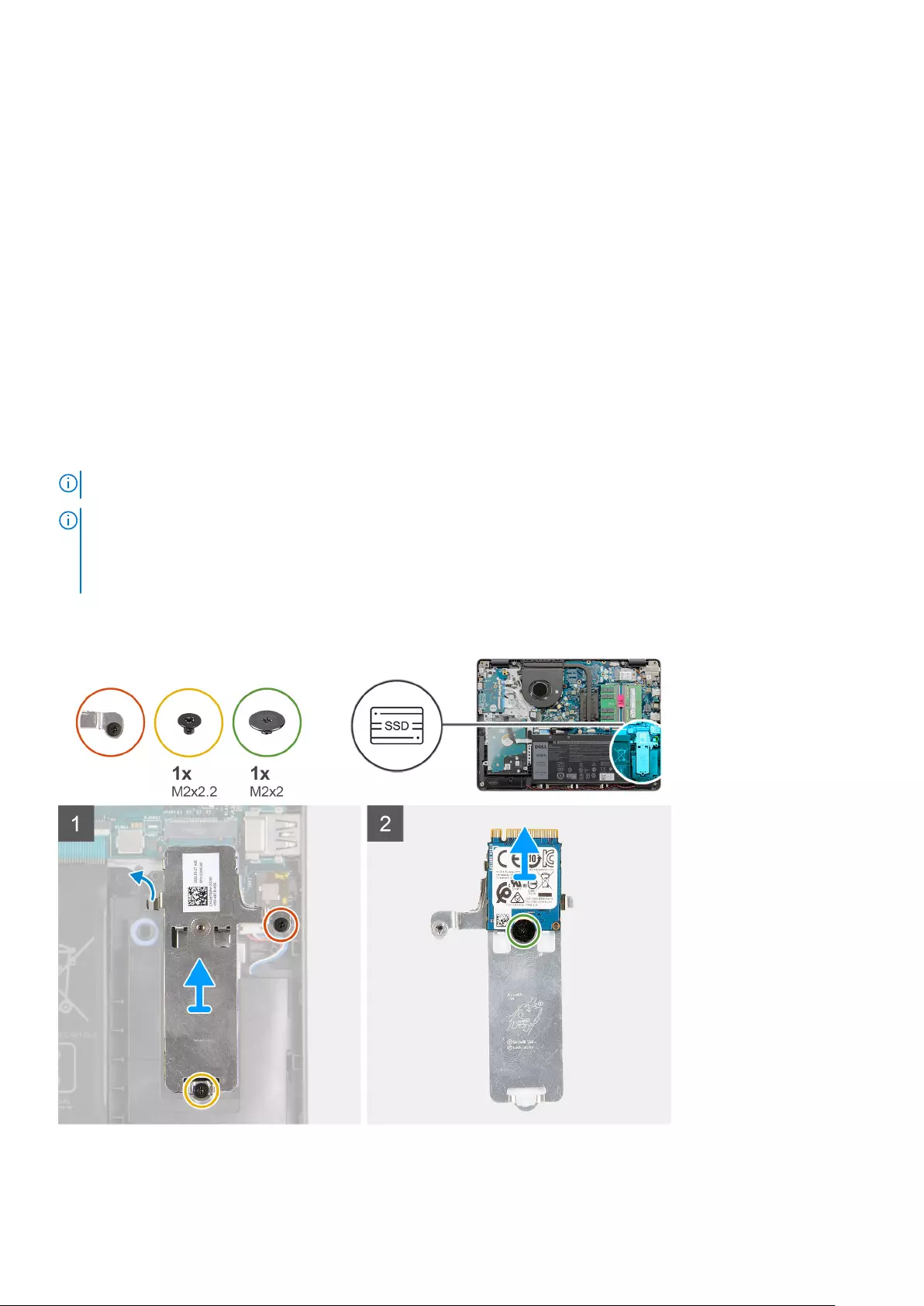
Next steps
1. Install the base cover.
2. Install the SD card.
3. Follow the procedure in After working inside your computer.
Solid-state drive
Removing the M.2 2230 solid-state drive
Prerequisites
1. Follow the procedure in Before working inside your computer.
2. Remove the SD card.
3. Remove the base cover.
4. Disconnect the battery.
About this task
NOTE: This procedure applies only to computers shipped with an M.2 2230 solid-state drive installed.
NOTE: The M.2 card installed on your computer will depend on the configuration ordered. Supported card configurations on
the M.2 card slot:
●M.2 2230 solid-state drive + 2230 mounting bracket
●M.2 2280 solid-state drive
The following images indicate the location of the M.2 2230 solid-state drive and provides a visual representation of the removal
procedure.
Disassembly and reassembly 23

Steps
1. Loosen the single captive screw and remove the single (M2x2.2) screw that secures SSD thermal plate to the palmrest, to
lift it out of the system.
2. Slide and remove the M.2 2230 mounting bracket off the system board.
3. Turn the thermal plate over and remove the single (M2x2) screw securing the M.2 2230 SSD to the thermal plate.
4. Slide and remove the M.2 2230 solid-state drive off the mounting bracket.
Installing the M.2 2230 solid-state drive
Prerequisites
If you are replacing a component, remove the existing component before performing the installation process.
About this task
NOTE: This procedure applies if you are installing a M.2 2230 solid-state drive.
NOTE: The M.2 card installed on your computer will depend on the configuration ordered. Supported card configurations on
the M.2 card slot:
●M.2 2230 solid-state drive + 2230 mounting bracket
●M.2 2280 solid-state drive
The following images indicate the location of the M.2 2230 solid-state drive and provides a visual representation of the
installation procedure.
Steps
1. Place the solid-state drive into the thermal plate and install the single (M2x2) screw.
2. Align the notch on the M.2 2230 solid-state drive with the tab on the M.2 card slot on the system board.
3. Slide the M.2 2230 solid-state drive into the M.2 card slot on the system board.
4. Replace the single (M2x2.2) screw and tighten the single captive screw to secures the thermal plate to the palmrest.
24 Disassembly and reassembly

Next steps
1. Reconnect the battery.
2. Install the base cover.
3. Install the SD card.
4. Follow the procedure in After working inside your computer.
Removing the M.2 2280 solid-state drive
Prerequisites
1. Follow the procedure in Before working inside your computer.
2. Remove the SD card.
3. Remove the base cover.
4. Disconnect the battery.
About this task
NOTE: This procedure applies only to computers shipped with a M.2 2280 solid-state drive installed.
NOTE: The M.2 card installed on your computer will depend on the configuration ordered. Supported card configurations on
the M.2 card slot:
●M.2 2230 solid-state drive + 2230 mounting bracket
●M.2 2280 solid-state drive
The following images indicate the location of the M.2 2280 solid-state drive and provides a visual representation of the removal
procedure.
Steps
1. Loosen the single captive screw and remove the single(M2x2.2) screws that secure the M.2 thermal shield to the palm-rest
and keyboard assembly.
2. Lift the M.2 thermal shield from the palm-rest and keyboard assembly.
Disassembly and reassembly 25

3. Slide and remove the M.2 2280 solid-state drive from the M.2 card slot on the system board.
Installing the M.2 2280 solid-state drive
Prerequisites
If you are replacing a component, remove the existing component before performing the installation process.
About this task
NOTE: This procedure applies if you are installing a M.2 2280 solid-state drive.
NOTE: The M.2 card installed on your computer will depend on the configuration ordered. Supported card configurations on
the M.2 card slot:
●M.2 2230 solid-state drive + 2230 mounting bracket
●M.2 2280 solid-state drive
The following images indicate the location of the M.2 2280 solid-state drive and provides a visual representation of the
installation procedure.
Steps
1. Align the notch on the M.2 2280 solid-state drive with the tab on the M.2 card slot on the system board.
2. Slide the M.2 2280 solid-state drive into the M.2 card slot on the system board.
3. Place the M.2 thermal shield on the M.2 2280 solid-state drive.
4. Align the screw holes on the M.2 thermal shield with the screw holes on the palm-rest and keyboard assembly.
5. Replace the single (M2x2.2) screw and tighten the single captive screw that secures the M.2 thermal shield to the palm-rest
and keyboard assembly.
Next steps
1. Reconnect the battery.
26 Disassembly and reassembly

2. Install the base cover.
3. Install the SD card.
4. Follow the procedure in After working inside your computer.
Wireless card
Removing the wireless card
Prerequisites
1. Follow the procedure in Before working inside your computer.
2. Remove the SD card.
3. Remove the base cover.
4. Disconnect the battery.
About this task
The following images indicate the location of the wireless card and provides a visual representation of the removal procedure.
Steps
1. Remove the screw (M2x3) that secures the wireless card bracket to the system board.
2. Lift the wireless card bracket off the left I/O-board.
3. Disconnect the antenna cables from the wireless card.
Disassembly and reassembly 27
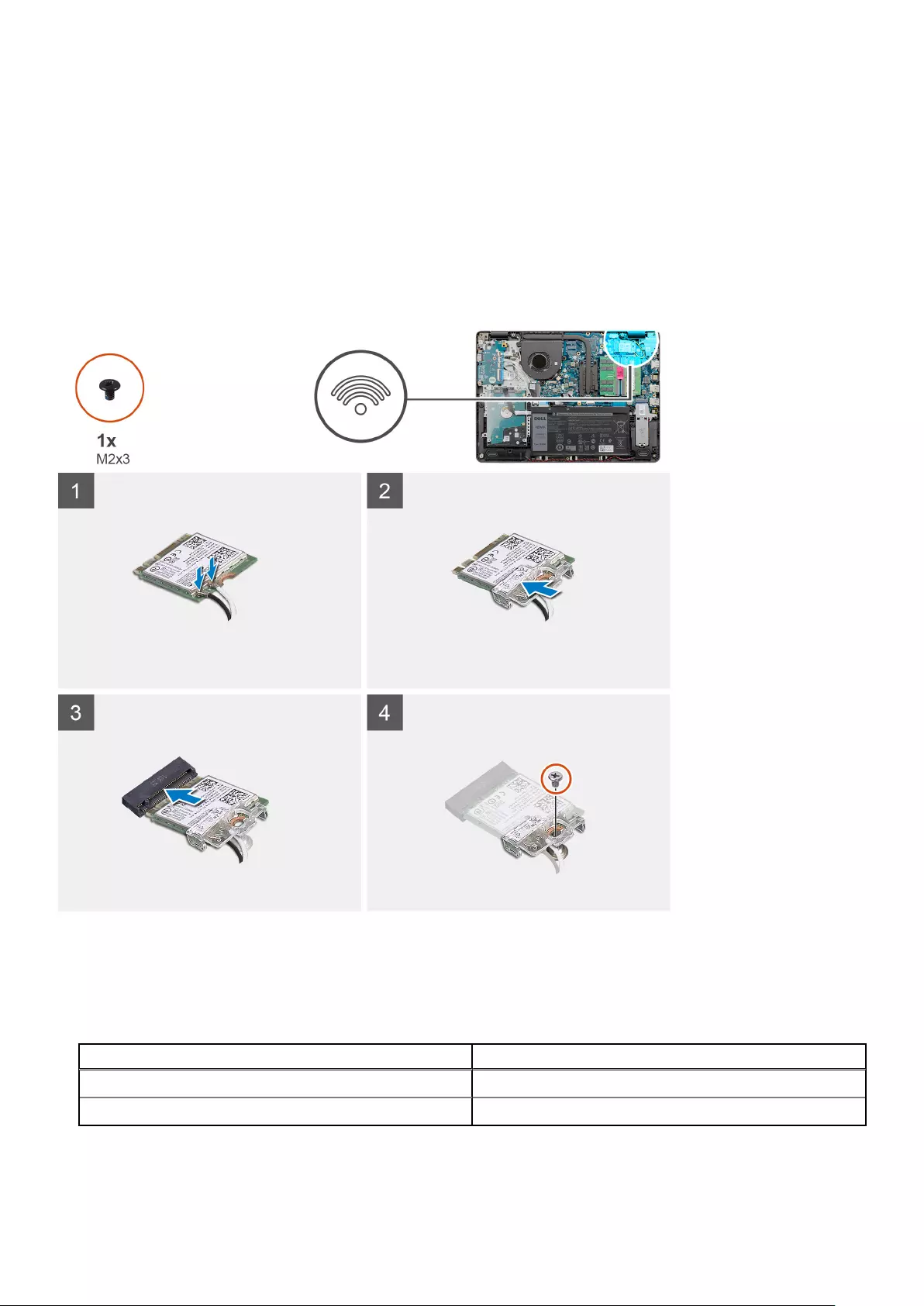
4. Slide and remove the wireless card from the M.2 card slot on the system board.
Installing the wireless card
Prerequisites
If you are replacing a component, remove the existing component before performing the installation process.
About this task
The following images indicate the location of the wireless card and provides a visual representation of the installation procedure.
Steps
1. Connect the antenna cables to the wireless card.
The following table provides the antenna-cable color scheme for the wireless card supported by your computer.
Table 1. Antenna-cable color scheme
Connectors on the wireless card Antenna-cable color
Main (white triangle) White
Auxiliary (black triangle) Black
2. Slide the wireless card into the M.2 card slot on the system board.
3. Place the wireless card bracket on the wireless card.
28 Disassembly and reassembly

4. Replace the screw (M2x3) that secures the wireless card bracket to the system board.
Next steps
1. Reconnect the battery.
2. Install the base cover.
3. Install the SD card.
4. Follow the procedure in After working inside your computer.
I/O board
Removing the I/O board
Prerequisites
1. Follow the procedure in Before working inside your computer.
2. Remove the SD card.
3. Remove the base cover.
4. Disconnect the battery.
About this task
The following images indicate the location of the I/O board and provides a visual representation of the removal procedure.
Steps
1. Open the latch and disconnect the fingerprint-reader board cable from the I/O board, if applicable.
Disassembly and reassembly 29
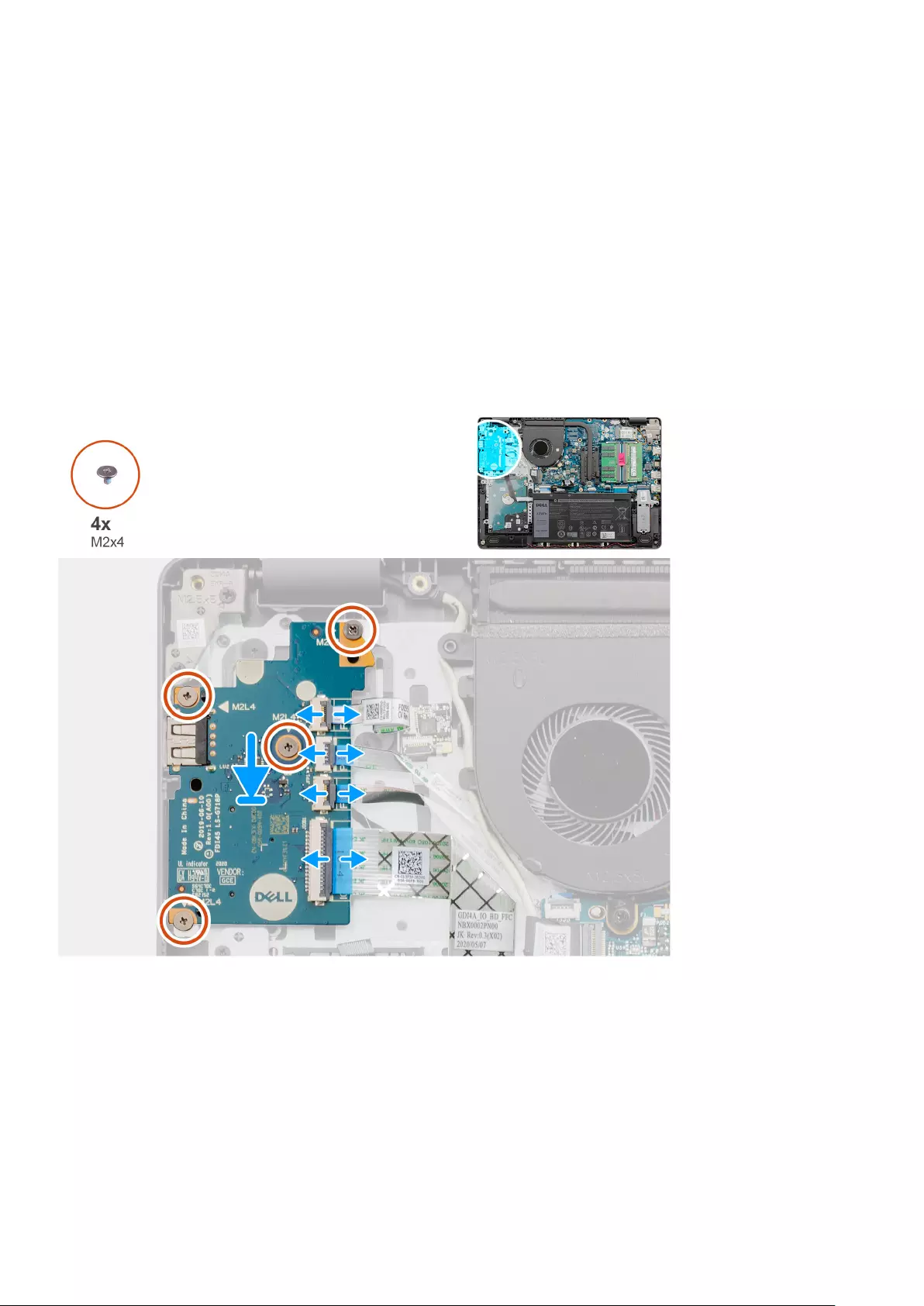
2. Open the latch and disconnect the I/O-board power cable from the I/O board.
3. Open the latch and disconnect the fingerprint-reader cable from the I/O board, if applicable.
4. Open the latch and disconnect the I/O-board cable from the I/O board.
5. Remove the four screws (M2x4) that secure the I/O board to the palm-rest and keyboard assembly.
6. Lift the I/O board off the palm-rest and keyboard assembly.
Installing the IO board
Prerequisites
If you are replacing a component, remove the existing component before performing the installation process.
About this task
The following images indicate the location of the I/O board and provides a visual representation of the installation procedure.
Steps
1. Place the I/O board on the palm-rest and keyboard assembly.
2. Align the screw holes on the I/O board to the screw holes on the palm-rest and keyboard assembly.
3. Replace the four screws (M2x4) that secure the I/O board to the palm-rest and keyboard assembly.
4. Connect the fingerprint-reader board cable to the connector on the I/O board and close the latch, if applicable.
5. Connect the I/O-board power cable to the connector on the I/O board and close the latch.
6. Connect the fingerprint-reader cable to the connector on the I/O board and close the latch, if applicable.
7. Connect the I/O-board cable to the connector on the I/O board and close the latch.
30 Disassembly and reassembly

Next steps
1. Install the battery.
2. Install the base cover.
3. Reconnect the SD card.
4. Follow the procedure in After working inside your computer.
Coin-cell battery
Removing the coin-cell battery
Prerequisites
1. Follow the procedure in Before working inside your computer.
2. Remove the SD card.
3. Remove the base cover.
4. Disconnect the battery.
5. Remove the IO board.
About this task
The following images indicate the location of the coin-cell battery and provides a visual representation of the removal procedure.
Steps
1. Flip the I/O board over.
2. Push on the securing clip to release the coin-cell battery from its holder on the I/O board.
3. Lift the coin-cell battery from its holder on the I/O board.
Installing the coin-cell battery
Prerequisites
If you are replacing a component, remove the existing component before performing the installation process.
Disassembly and reassembly 31

About this task
The following images indicate the location of the coin-cell battery and provides a visual representation of the installation
procedure.
Steps
1. Place the coin-cell battery into the coin-cell battery holder on the I/O board with the plus sign facing up.
2. Press down on the coin-cell battery to lock it in place in the coin-cell battery holder.
Next steps
1. Install the IO board.
2. Reconnect the battery.
3. Install the base cover.
4. Install the SD card.
5. Follow the procedure in After working inside your computer.
Hard drive
Removing the hard drive
Prerequisites
1. Follow the procedure in Before working inside your computer.
2. Remove the SD card.
3. Remove the base cover.
4. Disconnect the battery.
About this task
The following images indicate the location of the hard drive and provides a visual representation of the removal procedure.
32 Disassembly and reassembly

Steps
1. Disconnect the hard-drive cable from the system board.
2. Remove the four screws (M2x4) that secure the hard-drive assembly to the palm-rest and keyboard assembly.
3. Lift the hard-drive assembly and its cable from the palm-rest and keyboard assembly.
4. Disconnect the hard-drive cable from the hard drive.
5. Remove the four screws (M3x3) that secure the hard-drive bracket to the hard drive.
6. Slide and remove the hard-drive bracket from the hard drive.
Installing the hard drive
Prerequisites
If you are replacing a component, remove the existing component before performing the installation process.
About this task
The following images indicate the location of the hard drive and provides a visual representation of the installation procedure.
Disassembly and reassembly 33

Steps
1. Place and slide the hard drive into the hard-drive bracket.
2. Align the screw holes on the hard-drive bracket with the screw holes on the hard drive.
3. Replace the four screws (M3x3) that secure the hard-drive bracket to the hard drive.
4. Connect the hard-drive cable to the hard drive.
5. Place the hard-drive assembly on the palm-rest and keyboard assembly.
6. Align the screw holes on the hard-drive assembly to the screw holes on the palm-rest and keyboard assembly.
7. Replace the four screws (M2x3) that secure the hard-drive assembly to the palm-rest and keyboard assembly.
8. Connect the hard-drive cable to the connector on the system board.
Next steps
1. Reconnect the battery.
2. Install the base cover.
3. Install the SD card.
4. Follow the procedure in After working inside your computer.
34 Disassembly and reassembly
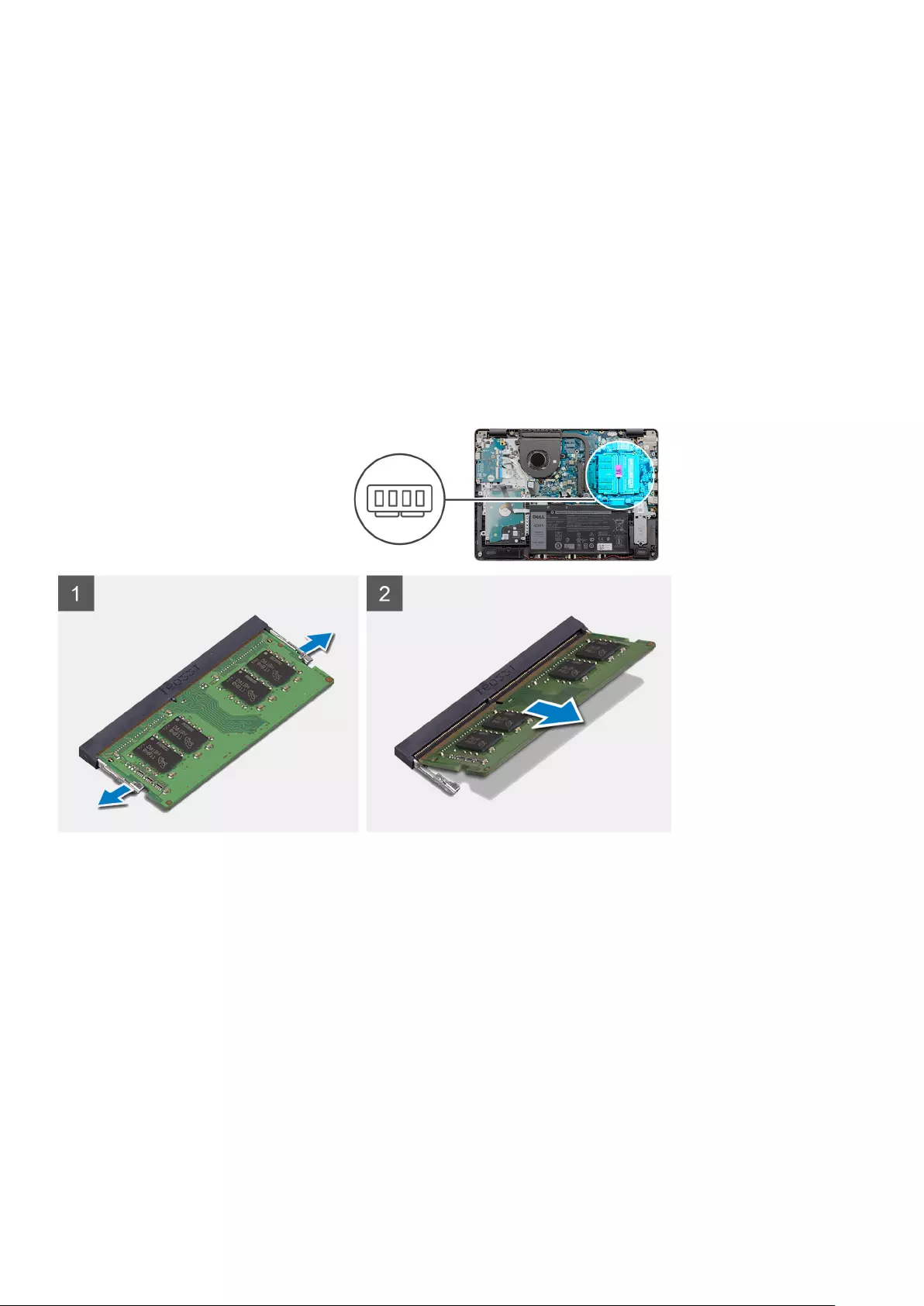
Memory modules
Removing the memory modules
Prerequisites
1. Follow the procedure in Before working inside your computer.
2. Remove the SD card.
3. Remove the base cover.
4. Disconnect the battery.
About this task
The following images indicate the location of the memory modules and provides a visual representation of the removal
procedure.
Steps
1. Use your fingertips to carefully spread apart the securing-clips on each end of the memory-module slot until the memory
module pops up.
2. Lift at an angle and remove the memory module from its slot on the system board.
3. Repeat the procedure above for the second memory module.
Installing the memory modules
Prerequisites
If you are replacing a component, remove the existing component before performing the installation process.
About this task
The following images indicate the location of the memory modules and provides a visual representation of the installation
procedure.
Disassembly and reassembly 35
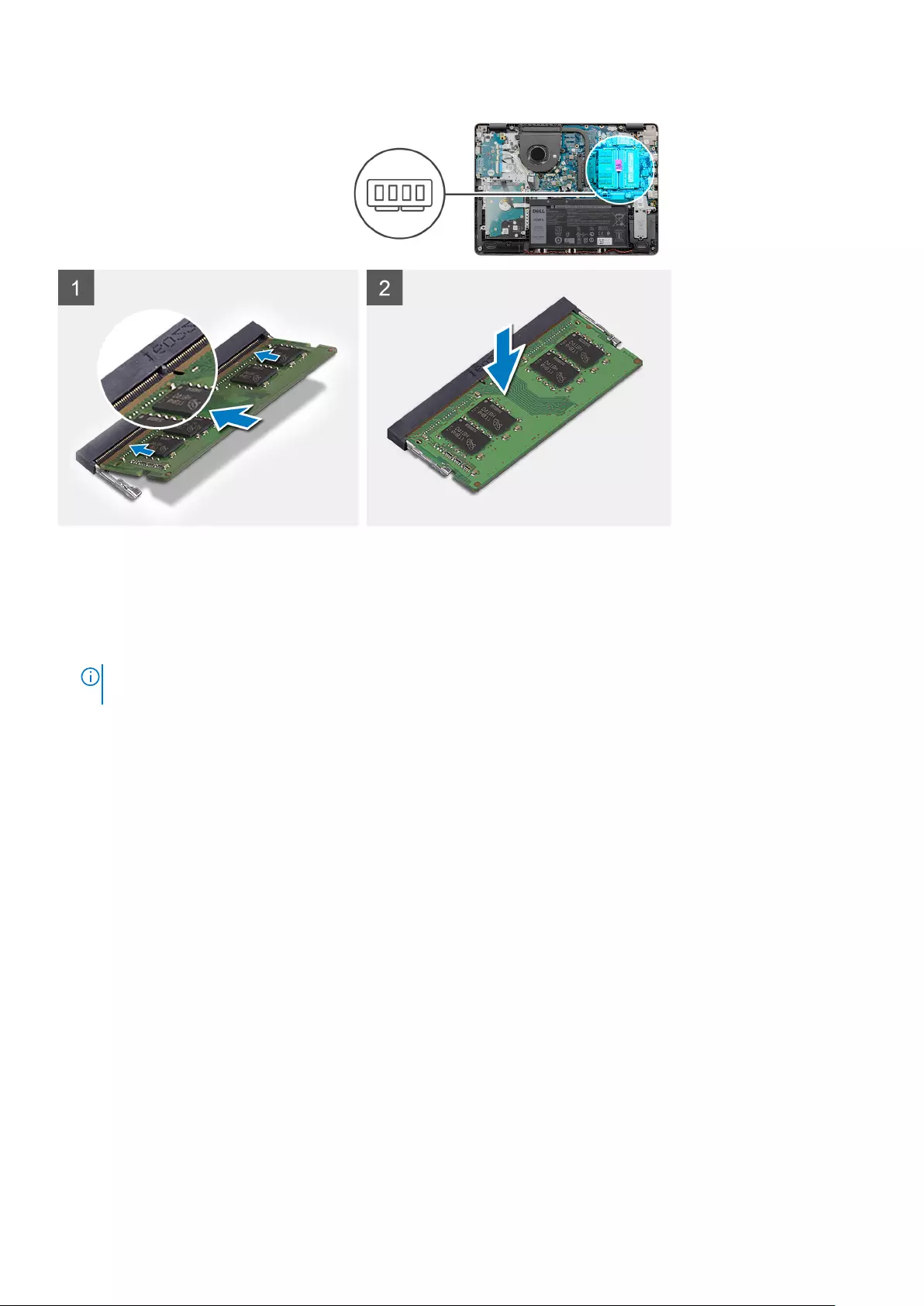
Steps
1. Align the slot on the memory module with the notch on the memory module slot on the system board.
2. Slide the memory module into the slot on the system board.
3. Press down on the memory module to snap it into place.
4. Ensure that the securing clips have locked the memory module into place.
NOTE: If the securing clips are not locking the memory module into place remove the memory module from the slot and
repeat steps 1 to 3.
5. Repeat the procedure above for the second memory module.
Next steps
1. Reconnect the battery.
2. Install the base cover.
3. Install the SD card.
4. Follow the procedure in After working inside your computer.
Speakers
Removing the speakers
Prerequisites
1. Follow the procedure in Before working inside your computer.
2. Remove the SD card.
3. Remove the base cover.
4. Disconnect the battery.
5. Remove the M.2 2230 solid-state drive.
6. Remove the M.2 2280 solid-state drive.
36 Disassembly and reassembly

About this task
The following images indicate the location of the speakers and provides a visual representation of the removal procedure.
Steps
1. Disconnect the speaker cable from the system board.
2. Remove the speaker cable from the routing guides on the palm-rest and keyboard assembly.
3. Lift the speakers along with its cable off the palm-rest and keyboard assembly.
Installing the speakers
Prerequisites
If you are replacing a component, remove the existing component before performing the installation process.
About this task
The following images indicate the location of the speakers and provides a visual representation of the installation procedure.
Disassembly and reassembly 37

Steps
1. Using the alignment posts, place the speakers on the palm-rest and keyboard assembly.
NOTE: Ensure that the alignment posts are threaded through the rubber grommets on the speaker.
2. Route the speaker cable through the routing guides on the palm-rest and keyboard assembly.
3. Connect the speaker cable to the system board.
Next steps
1. Install the M.2 2230 solid-state drive.
2. Install the M.2 2280 solid-state drive.
3. Reconnect the battery.
4. Install the base cover.
5. Install the SD card.
6. Follow the procedure in After working inside your computer.
Heat sink
Removing the heat sink
Prerequisites
1. Follow the procedure in Before working inside your computer.
2. Remove the SD card.
3. Remove the base cover.
4. Disconnect the battery.
About this task
NOTE: The heat sink may become hot during normal operation. Allow sufficient time for the heat sink to cool before you
touch it.
NOTE: For maximum cooling of the processor, do not touch the heat transfer areas on the heat sink. The oils in your skin
can reduce the heat transfer capability of the thermal grease.
38 Disassembly and reassembly

The following images indicate the location of the heat sink and provides a visual representation of the removal procedure.
Steps
1. In reverse sequential order (4>3>2>1) loosen the four captive screws that secure the heat sink to the system board.
NOTE: The number of screws varies depending on the configuration ordered.
2. Lift the heat sink from the system board.
Installing the heat sink
Prerequisites
If you are replacing a component, remove the existing component before performing the installation process.
About this task
NOTE: If either the system board or the heat sink is replaced, use the thermal grease provided in the kit to ensure that
thermal conductivity is achieved.
The following images indicate the location of the heat sink and provides a visual representation of the installation procedure.
Disassembly and reassembly 39
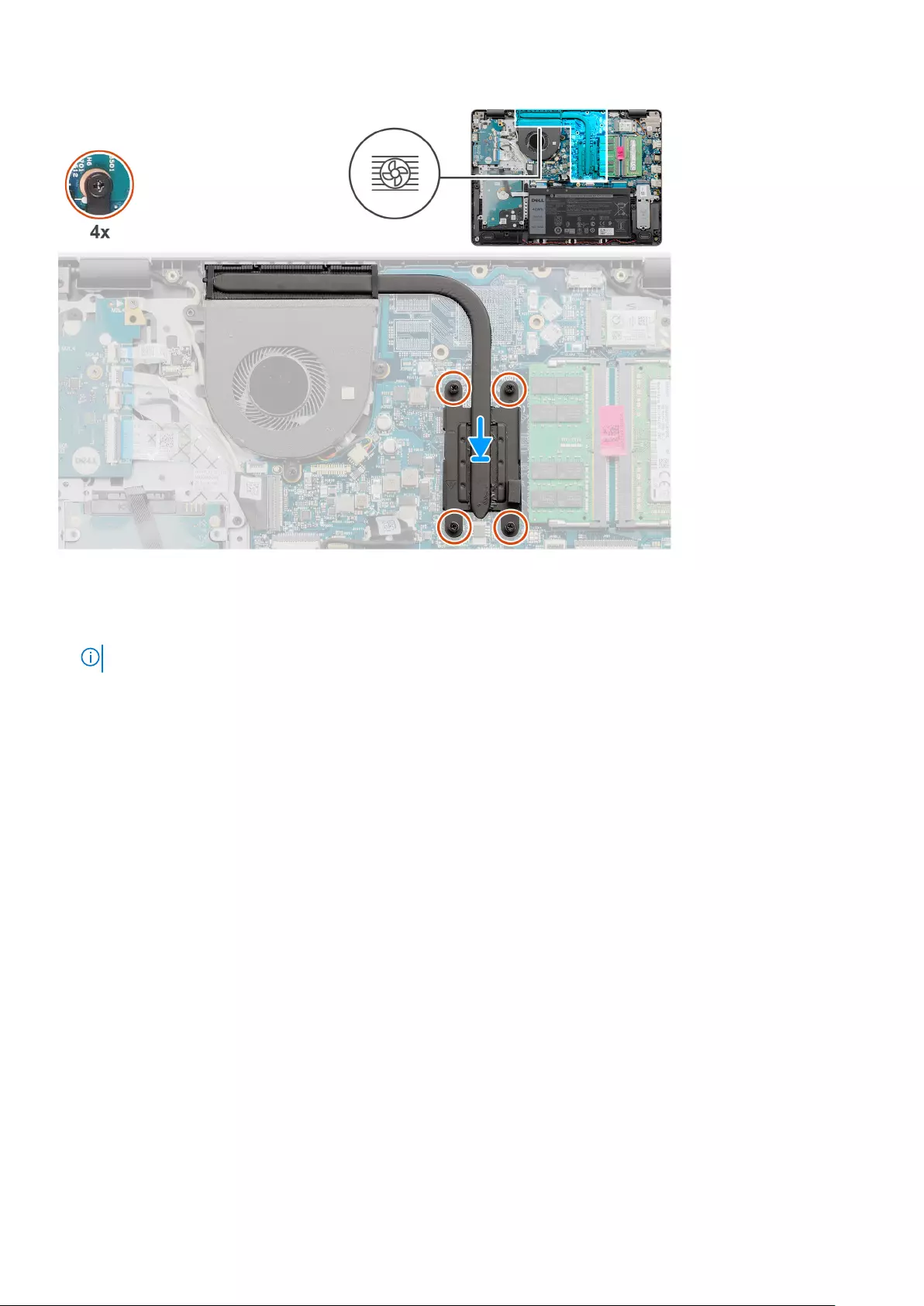
Steps
1. Place the heat sink on the system board.
2. In sequential order (1>2>3>4) tighten the four captive screws that secure the heat sink to the system board.
NOTE: The number of screws varies depending on the configuration ordered.
Next steps
1. Reconnect the battery.
2. Install the base cover.
3. Install the SD card.
4. Follow the procedure in After working inside your computer.
Fan
Removing the fan
Prerequisites
1. Follow the procedure in Before working inside your computer.
2. Remove the SD card.
3. Remove the base cover.
4. Disconnect the battery.
About this task
The following images indicate the location of the fan and provides a visual representation of the removal procedure.
40 Disassembly and reassembly

Steps
1. Remove the two screws (M2.5x5) that secure the fan to the palm-rest and keyboard assembly.
2. Disconnect the fan cable from the system board.
3. Lift the fan from the palm-rest and keyboard assembly.
Installing the fan
Prerequisites
If you are replacing a component, remove the existing component before performing the installation process.
About this task
The following images indicate the location of the fan and provides a visual representation of the installation procedure.
Disassembly and reassembly 41

Steps
1. Place the fan on the palm-rest and keyboard assembly.
2. Align the screw holes on the fan to the screw holes on the palm-rest and keyboard assembly.
3. Replace the two screws (M2.5x5) that secure the fan to the palm-rest and keyboard assembly.
4. Connect the fan cable to the connector on the system board.
Next steps
1. Reconnect the battery.
2. Install the base cover.
3. Install the SD card.
4. Follow the procedure in After working inside your computer.
Power button
Removing the power-button with optional fingerprint reader
Prerequisites
1. Follow the procedure in Before working inside your computer.
2. Remove the SD card.
3. Remove the base cover.
4. Remove the battery.
5. Remove the IO board.
About this task
The following images indicate the location of the power-button with optional fingerprint reader and provides a visual
representation of the removal procedure.
42 Disassembly and reassembly

Steps
1. Remove the two screws (M2x2) that secure the power-button with optional fingerprint reader to the palm-rest and
keyboard assembly.
2. Open the latch and disconnect the power-button cable from the fingerprint-reader board, if applicable.
3. Peel the tape that secures the power-button cable to the palm-rest and keyboard assembly, if applicable.
4. Lift the power-button, along with its cable, off the palm-rest and keyboard assembly.
Installing the power button
Prerequisites
If you are replacing a component, remove the existing component before performing the installation process.
About this task
The following images indicate the location of the power-button with optional fingerprint reader and provides a visual
representation of the installation procedure.
Disassembly and reassembly 43
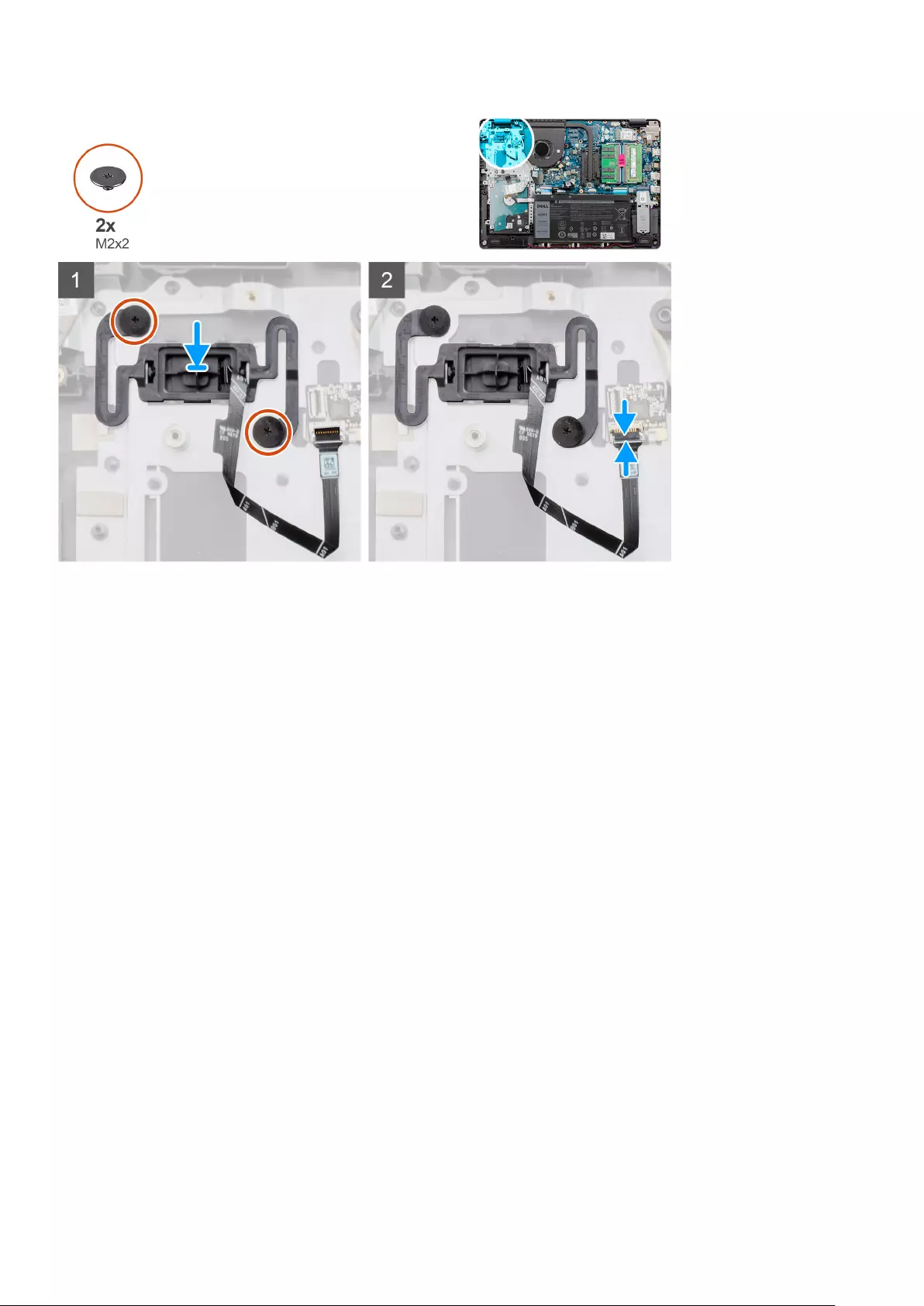
Steps
1. Using the alignment posts, place the power-button into its slot on the palm-rest and keyboard assembly.
2. Replace the two screws (M2x2) that secure the power-button to the palm-rest and keyboard assembly.
3. Connect the power-button cable to the fingerprint-reader board and close the latch, if applicable.
4. Adhere the tape that secures the power-button cable to the palm-rest and keyboard assembly, if applicable.
Next steps
1. Install the IO board.
2. Install the battery.
3. Install the base cover.
4. Install the SD card.
5. Follow the procedure in After working inside your computer.
Display assembly
Removing the display assembly
Prerequisites
1. Follow the procedure in Before working inside your computer.
2. Remove the SD card.
3. Remove the base cover.
4. Remove the battery.
5. Remove the wireless card.
About this task
The following images indicate the location of the display assembly and provides a visual representation of the removal
procedure.
44 Disassembly and reassembly

Disassembly and reassembly 45
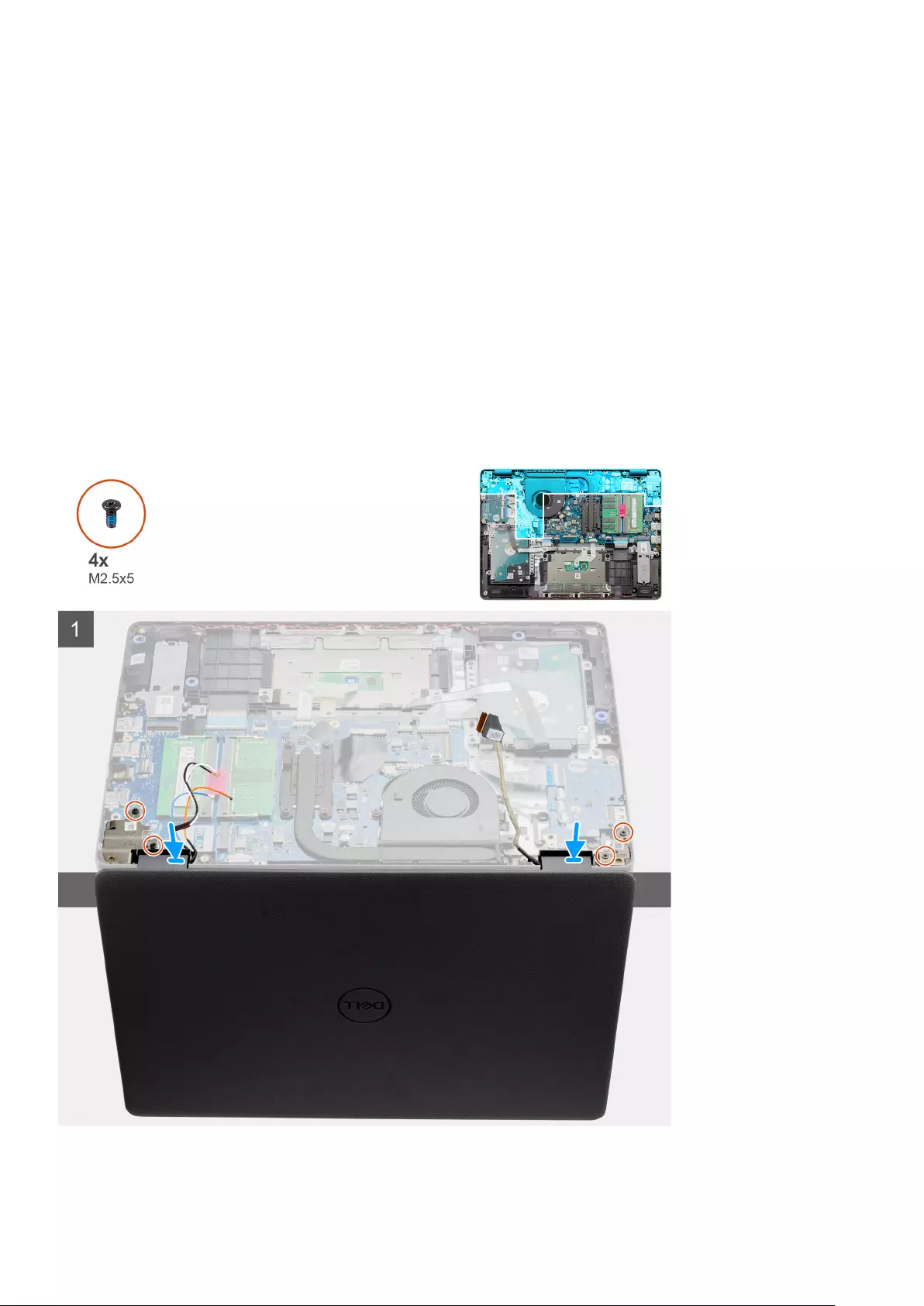
Steps
1. Disconnect the display cable from the system board.
2. Remove the display cable from the routing guides on the palm-rest and keyboard assembly.
3. Open the display and place the computer with the lid open at the edge of a stable elevation with the display hanging
downwards.
4. Remove the six screws (M2.5x5) that secure the display hinges to the palm-rest and keyboard assembly.
5. Lift the display assembly from the palm-rest and keyboard assembly.
Installing the display assembly
Prerequisites
If you are replacing a component, remove the existing component before performing the installation process.
About this task
The following images indicate the location of the display assembly and provides a visual representation of the installation
procedure.
46 Disassembly and reassembly

Steps
1. Place the display assembly on the palm-rest and keyboard assembly.
2. Align the screw holes on the display hinges with the screw holes on the palm-rest and keyboard assembly.
3. Replace the 6 screws (M2.5x5) that secure the display hinges to the palm-rest and keyboard assembly.
4. Route the display cable through the routing guides on the palm-rest and keyboard assembly.
5. Connect the display cable to the connector on the system board.
Next steps
1. Install the wireless card.
2. Install the battery.
3. Install the base cover.
4. Install the SD card.
5. Follow the procedure in After working inside your computer.
Display bezel
Removing the display bezel
Prerequisites
1. Follow the procedure in Before working inside your computer.
2. Remove the SD card.
3. Remove the base cover.
4. Remove the battery.
5. Remove the display assembly.
Disassembly and reassembly 47

About this task
Steps
1. Pry open the display bezel from the inner edge at the left and right sides of the display assembly.
2. Pry open the display bezel from the inner edge at the top side of the display assembly.
3. Pry open the hinge caps at the bottom side of the display assembly.
4. Pry open the display bezel from the inner edge at the bottom side of the display assembly.
5. Lift and remove the display bezel from the display assembly
NOTE: CAUTION: DO NOT use a scribe or any other objects to pry up the display bezel in the manners shown in the
images below as the pressure applied on the display panel by the scribe will damage the display panel.
48 Disassembly and reassembly

Installing the display bezel
Prerequisites
If you are replacing a component, remove the existing component before performing the installation procedure.
Disassembly and reassembly 49

About this task
Steps
Align the display bezel with the display back-cover and antenna assembly, and then gently snap the display bezel into place.
Next steps
1. Install the display assembly.
2. Reconnect the battery.
3. Install the base cover.
4. Install the SD card.
5. Follow the procedure in after working inside your computer.
Display panel
Removing the display panel
Prerequisites
1. Follow the procedure in Before working inside your computer.
2. Remove the SD card.
3. Remove the base cover.
4. Remove the wireless card.
5. Remove the display assembly.
6. Remove the display bezel.
About this task
The following images indicate the location of the display panel and provides a visual representation of the removal procedure.
50 Disassembly and reassembly
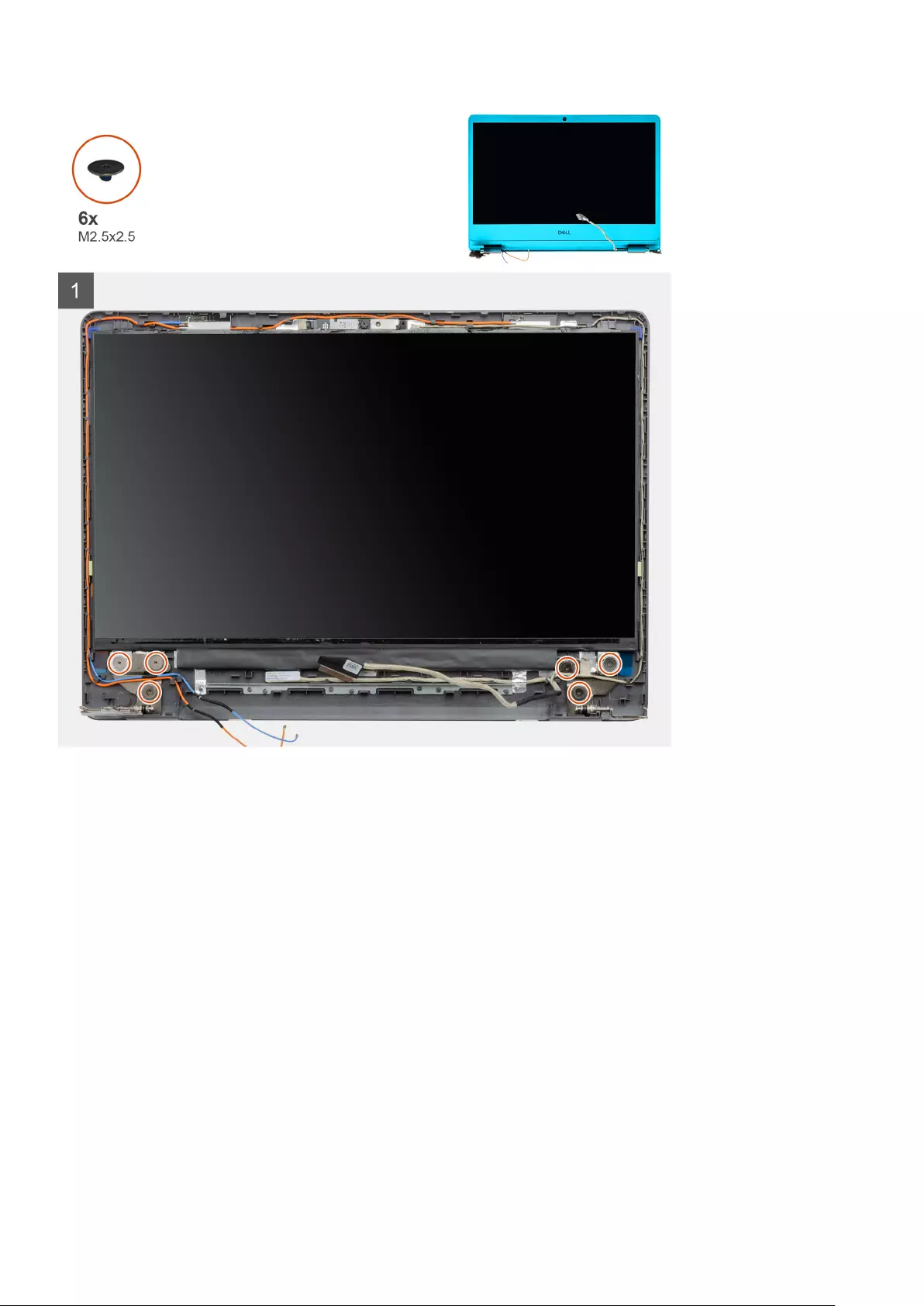
Disassembly and reassembly 51

Steps
1. Remove the six screws (M2.5x2.5) that secure the display panel to the display assembly.
2. Lift and rotate the display panel forward.
NOTE: Ensure that the display panel has a smooth and clean surface to rest on to prevent damage.
3. Disconnect the display cable from the display panel.
4. Peel the tape that secures the display-cable connector latch to the display panel.
5. Lift the display-cable latch and disconnect the display cable from the display panel.
6. Lift the display panel off the display assembly.
NOTE: Do not remove the metal brackets from the panel.
Installing the display panel
Prerequisites
If you are replacing a component, remove the existing component before performing the installation process.
About this task
The following images indicate the location of the display panel and provides a visual representation of the installation procedure.
52 Disassembly and reassembly

Disassembly and reassembly 53

Steps
1. Place the display panel and display assembly on a clean and flat surface.
2. Connect the display cable to the connector on the display panel and close the latch.
3. Adhere the tape that secures the display-cable connector latch to the display panel.
54 Disassembly and reassembly

4. Lift and rotate the display panel, then place the display panel on the display assembly.
5. Align the screw holes on the display panel to the screw holes on the display assembly.
6. Replace the six screws (M2.5x2.5) that secure the display panel to the display assembly.
7. Place the display bezel on the display assembly.
8. Align the tabs on the display bezel to the slots on the display assembly.
9. Press down on the display bezel and snap the display bezel in place.
Next steps
1. Install the display bezel.
2. Install the display assembly.
3. Install the wireless card.
4. Install the battery.
5. Install the base cover.
6. Install the SD card.
7. Follow the procedure in After working inside your computer.
Camera
Removing the camera module
Prerequisites
1. Follow the procedure in Before working inside your computer.
2. Remove the SD card.
3. Remove the base cover.
4. Disconnect the battery .
5. Remove the wireless card.
6. Remove the display assembly.
7. Remove the display panel.
8. Remove the display bezel.
About this task
The following images indicate the location of the camera module and provides a visual representation of the removal procedure.
Disassembly and reassembly 55

Steps
1. Using the pull tab, disconnect the camera cable from the camera module.
2. Using a plastic scribe, pry the camera module from the display assembly.
3. Lift the camera off the display assembly.
Installing the camera module
Prerequisites
If you are replacing a component, remove the existing component before performing the installation process.
About this task
The following images indicate the location of the camera module and provides a visual representation of the installation
procedure.
56 Disassembly and reassembly

Steps
1. Adhere the camera module in its slot on the display assembly.
2. Connect the camera cable to the camera module.
Next steps
1. Install the display bezel.
2. Install the display panel.
3. Install the display assembly.
4. Install the wireless card.
5. Install the base cover.
6. Install the SD card.
7. Follow the procedure in After working inside your computer.
Touchpad
Removing the touchpad
Prerequisites
1. Follow the procedure in Before working inside your computer.
2. Remove the SD card.
3. Remove the base cover.
4. Remove the battery.
About this task
The following images indicate the location of the touchpad and provides a visual representation of the removal procedure.
Disassembly and reassembly 57

Steps
1. Open the latch and disconnect the touchpad cable from the touchpad.
2. Remove the three screws (M2x2) that secure the touchpad bracket to the palm-rest and keyboard assembly.
3. Lift the touchpad bracket off the touchpad.
4. Remove the two screws (M2x2) that secure the touchpad to the palm-rest and keyboard assembly.
5. Peel the tape that secures the touchpad to the palm-rest and keyboard assembly.
6. Lift the touchpad off the palm-rest and keyboard assembly.
Installing the touchpad
Prerequisites
If you are replacing a component, remove the existing component before performing the installation process.
About this task
The following images indicate the location of the touchpad and provides a visual representation of the installation procedure.
58 Disassembly and reassembly

Steps
1. Place the touchpad into its slot on the palm-rest and keyboard assembly.
2. Align the screw holes on the touchpad to the screw holes on the palm-rest and keyboard assembly.
3. Turn the computer over and open the display to ensure that the touchpad is equally aligned on all sides.
4. Close the display and place the computer in the position shown.
5. Replace the two screws (M2x2) that secure the touchpad to the palm-rest and keyboard assembly.
6. Adhere the tape that secures the touchpad to the palm-rest and keyboard assembly.
7. Place the touchpad bracket on the touchpad.
NOTE: When installing the touchpad bracket into Vostro 3405, insert its top corners under the two tabs on the palm
rest.
8. Align the screw holes on the touchpad bracket to the screw holes on the palm-rest and keyboard assembly.
9. Replace the three screws (M2x2) that secure the touchpad bracket to the palm-rest and keyboard assembly.
10. Connect the touchpad cable to the touchpad and close the latch.
Disassembly and reassembly 59

Next steps
1. Install the battery.
2. Install the base cover.
3. Install the SD card.
4. Follow the procedure in After working inside your computer.
System board
Removing the system board
Prerequisites
1. Follow the procedure in Before working inside your computer.
2. Remove the SD card.
3. Remove the base cover.
4. Remove the battery.
5. Remove the M.2 2230 solid-state drive.
6. Remove the M.2 2280 solid-state drive.
7. Remove the memory modules.
8. Remove the fan.
9. Remove the heat sink.
10. Remove the wireless card.
11. Remove the display assembly.
About this task
The following images indicate the location of the system board and provides a visual representation of the removal procedure.
60 Disassembly and reassembly

Disassembly and reassembly 61

Steps
1. Remove the two (M2.5x5) screws from the right hinge.
2. Fold the right hinge up.
3. Disconnect the following cables from the system board:
a. Speaker cable
b. Keyboard FFC
c. Power adapter port cable
d. Keyboard backlight FFC
e. Touchpad FFC
f. Hard drive FFC
g. IO board FFC
h. fingerprint reader FFC
i. power button FFC from the system board
4. Remove the single (M2x4) screw that secures the system board to the palmrest.
5. Carefully lift the system board away from the chassis.
Installing the system board
Prerequisites
If you are replacing a component, remove the existing component before performing the installation process.
About this task
The following images indicate the location of the system board and provides a visual representation of the installation procedure.
62 Disassembly and reassembly

Disassembly and reassembly 63
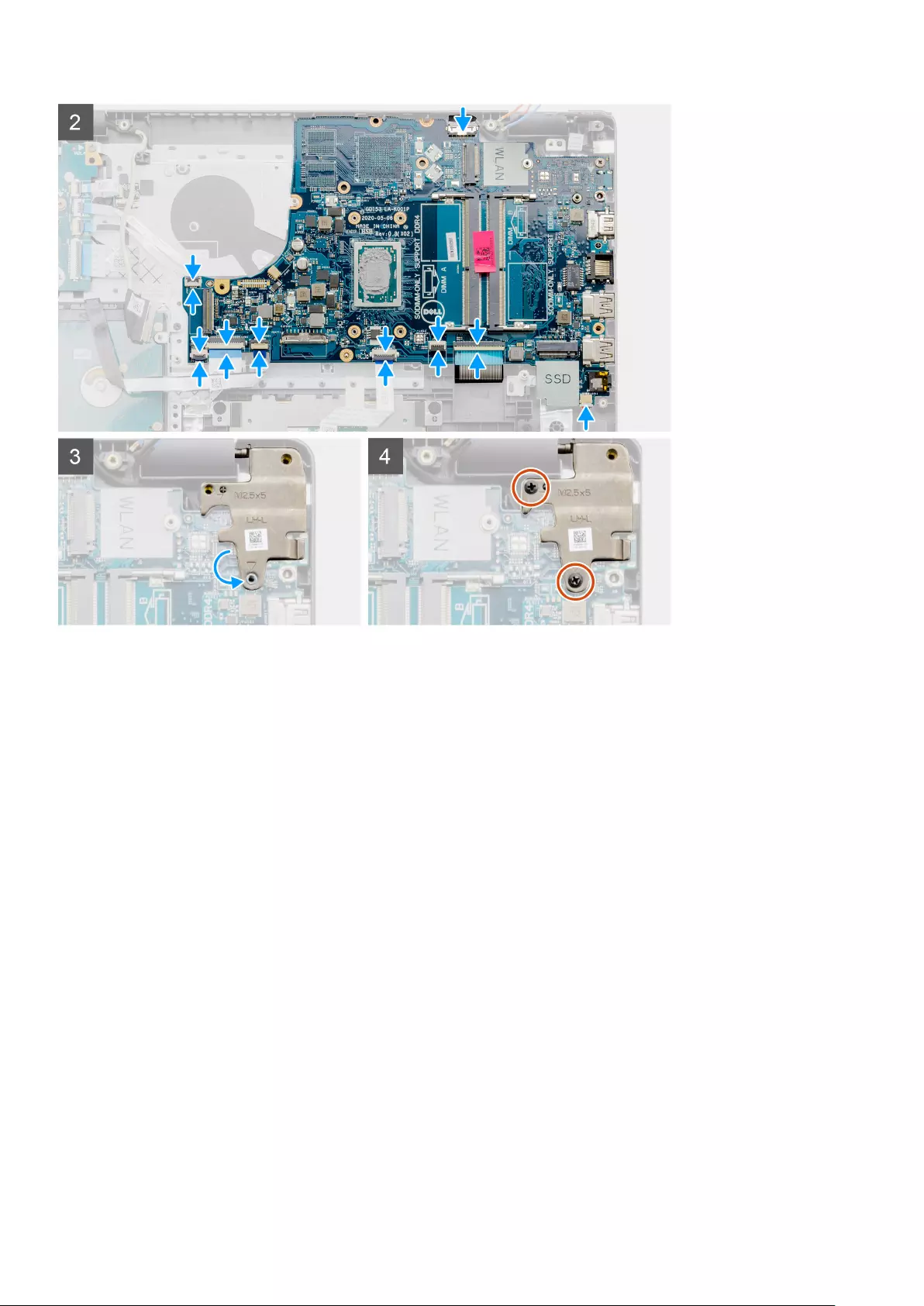
Steps
1. Align and place the system board on the palmrest.
2. Replace the single (M2x4) screw that secures the system board to the palmrest.
3. Connect the following cables to the system board:
a. Speaker cable
b. Keyboard FFC
c. Keyboard backlight FFC
d. Touchpad FFC
e. Hard drive FFC
f. IO board FFC
g. Power adapter port cable
h. Fingerprint reader FFC
i. Power button FFC from the system board
4. Fold back the right hinge and install the two (M2.5x5) screws to secure it to the palmrest.
Next steps
1. Install the display assembly.
2. Install the wireless card.
3. Install the heat sink.
4. Install the fan.
5. Install the memory modules.
6. Install the M.2 2230 solid-state drive.
7. Install the M.2 2280 solid-state drive.
8. Install the battery.
9. Install the base cover.
10. Install the SD card.
64 Disassembly and reassembly

11. Follow the procedure in After working inside your computer.
Power-adapter port
Removing the power-adapter port
Prerequisites
1. Follow the procedure in Before working inside your computer.
2. Remove the SD card.
3. Remove the base cover.
4. Remove the battery.
5. Remove the M.2 2230 solid-state drive.
6. Remove the M.2 2280 solid-state drive.
7. Remove the fan.
8. Remove the wireless card.
9. Remove the display assembly.
10. Remove the system board.
NOTE: The system board can be removed along with the heat sink.
About this task
The following images indicate the location of the power-adapter port and provides a visual representation of the removal
procedure.
Steps
Lift the power-adapter port from its slot on the palm-rest and keyboard assembly.
Disassembly and reassembly 65

Installing the power-adapter port
Prerequisites
If you are replacing a component, remove the existing component before performing the installation process.
About this task
The following images indicate the location of the power-adapter port and provides a visual representation of the installation
procedure.
Steps
Place the power-adapter port into its slot on the palm-rest and keyboard assembly.
Next steps
1. Install the system board
2. Install the display assembly.
3. Install the wireless card.
4. Install the fan.
5. Install the M.2 2230 solid-state drive.
6. Install the M.2 2280 solid-state drive.
7. Install the battery.
8. Install the base cover.
9. Install the SD card.
10. Follow the procedure in After working inside your computer.
66 Disassembly and reassembly

Palm-rest and keyboard assembly
Removing the palm-rest and keyboard assembly
Prerequisites
1. Follow the procedure in Before working inside your computer.
2. Remove the SD card.
3. Remove the base cover.
4. Remove the battery.
5. Remove the M.2 2230 solid-state drive.
6. Remove the M.2 2280 solid-state drive.
7. Remove the hard drive.
8. Remove the fan.
9. Remove the wireless card.
10. Remove the display assembly.
11. Remove the touchpad.
12. Remove the speakers.
13. Remove the IO board.
14. Remove the power button.
15. Remove the system board.
NOTE: The system board can be removed along with the heat sink.
16. Remove the power-adapter port.
About this task
The following images indicate the location of the palm-rest and keyboard assembly and provides a visual representation of the
removal procedure.
Steps
After performing the pre-requisites you are left with the palm-rest and keyboard assembly.
Disassembly and reassembly 67

Installing the palm-rest and keyboard assembly
Prerequisites
If you are replacing a component, remove the existing component before performing the installation process.
About this task
The following images indicate the location of the palm-rest and keyboard assembly and provides a visual representation of the
installation procedure.
Steps
Place the palm-rest and keyboard assembly on a flat and clean surface and perform the post-requisites to install the palm-rest
and keyboard assembly.
Next steps
1. Install the power-adapter port.
2. Install the system board.
3. Install the power button.
4. Install the IO board.
5. Install the speakers.
6. Install the touchpad.
7. Install the display assembly.
8. Install the wireless card.
9. Install the fan.
10. Install the hard drive.
11. Install the M.2 2230 solid-state drive.
12. Install the M.2 2280 solid-state drive.
13. Install the battery.
14. Install the base cover.
15. Install the SD card.
16. Follow the procedure in After working inside your computer.
68 Disassembly and reassembly

Troubleshooting
Topics:
•Handling swollen Lithium-ion batteries
•Dell SupportAssist Pre-boot System Performance Check diagnostics
•System diagnostic lights
•Real-Time Clock (RTC Reset)
•Updating the BIOS in Windows
•Updating the BIOS using the USB drive in Windows
•Backup media and recovery options
•WiFi power cycle
•Drain residual flea power (perform hard reset)
Handling swollen Lithium-ion batteries
Like most laptops, Dell laptops use lithium-ion batteries. One type of lithium-ion battery is the lithium-ion polymer battery.
Lithium-ion polymer batteries have increased in popularity in recent years and have become standard in the electronics industry
due to customer preferences for a slim form factor (especially with newer ultra-thin laptops) and long battery life. Inherent to
lithium-ion polymer battery technology is the potential for swelling of the battery cells.
Swollen battery may impact the performance of the laptop. To prevent possible further damage to the device enclosure or
internal components leading to malfunction, discontinue the use of the laptop and discharge it by disconnecting the AC adapter
and letting the battery drain.
Swollen batteries should not be used and should be replaced and disposed of properly. We recommend contacting Dell product
support for options to replace a swollen battery under the terms of the applicable warranty or service contract, including options
for replacement by a Dell authorized service technician.
The guidelines for handling and replacing Lithium-ion batteries are as follows:
●Exercise caution when handling Lithium-ion batteries.
●Discharge the battery before removing it from the system. To discharge the battery, unplug the AC adapter from the system
and operate the system only on battery power. When the system will no longer power on when the power button is pressed,
the battery is fully discharged.
●Do not crush, drop, mutilate, or penetrate the battery with foreign objects.
●Do not expose the battery to high temperatures, or disassemble battery packs and cells.
●Do not apply pressure to the surface of the battery.
●Do not bend the battery.
●Do not use tools of any type to pry on or against the battery.
●If a battery gets stuck in a device as a result of swelling, do not try to free it as puncturing, bending, or crushing a battery
can be dangerous.
●Do not attempt to reassemble a damaged or swollen battery into a laptop.
●Swollen batteries that are covered under warranty should be returned to Dell in an approved shipping container (provided
by Dell)—this is to comply with transportation regulations. Swollen batteries that are not covered under warranty should be
disposed of at an approved recycling center. Contact Dell product support at https://www.dell.com/support for assistance
and further instructions.
●Using a non-Dell or incompatible battery may increase the risk of fire or explosion. Replace the battery only with a
compatible battery purchased from Dell that is designed to work with your Dell computer. Do not use a battery from other
computers with your computer. Always purchase genuine batteries from https://www.dell.com or otherwise directly from
Dell.
Lithium-ion batteries can swell for various reasons such as age, number of charge cycles, or exposure to high heat. For more
information on how to improve the performance and lifespan of the laptop battery and to minimize the possibility of occurrence
of the issue, see Dell Laptop Battery - Frequently Asked Questions.
4
Troubleshooting 69

Dell SupportAssist Pre-boot System Performance
Check diagnostics
About this task
SupportAssist diagnostics (also known as system diagnostics) performs a complete check of your hardware. The Dell
SupportAssist Pre-boot System Performance Check diagnostics is embedded with the BIOS and is launched by the BIOS
internally. The embedded system diagnostics provides a set of options for particular devices or device groups allowing you to:
●Run tests automatically or in an interactive mode
●Repeat tests
●Display or save test results
●Run thorough tests to introduce additional test options to provide extra information about the failed device(s)
●View status messages that inform you if tests are completed successfully
●View error messages that inform you of problems encountered during testing
NOTE: Some tests for specific devices require user interaction. Always ensure that you are present at the computer
terminal when the diagnostic tests are performed.
For more information, see https://www.dell.com/support/kbdoc/000180971.
Running the SupportAssist Pre-Boot System Performance Check
Steps
1. Turn on your computer.
2. As the computer boots, press the F12 key as the Dell logo appears.
3. On the boot menu screen, select the Diagnostics option.
4. Click the arrow at the bottom left corner.
Diagnostics front page is displayed.
5. Click the arrow in the lower-right corner to go to the page listing.
The items detected are listed.
6. To run a diagnostic test on a specific device, press Esc and click Yes to stop the diagnostic test.
7. Select the device from the left pane and click Run Tests.
8. If there are any issues, error codes are displayed.
Note the error code and validation number and contact Dell.
System diagnostic lights
Battery-status light
Indicates the power and battery-charge status.
Solid white — Power adapter is connected and the battery has more than 5 percent charge.
Amber — Computer is running on battery and the battery has less than 5 percent charge.
Off
●Power adapter is connected and the battery is fully charged.
●Computer is running on battery and the battery has more than 5 percent charge.
●Computer is in sleep state, hibernation, or turned off.
The power and battery-status light blinks amber along with beep codes indicating failures.
For example, the power and battery-status light blinks amber two times followed by a pause, and then blinks white three times
followed by a pause. This 2,3 pattern continues until the computer is turned off indicating no memory or RAM is detected.
The following table shows different power and battery-status light patterns and associated problems.
70 Troubleshooting

Table 2. LED codes
Diagnostic light codes Problem description Recommended solutions
2,1 Processor failure Run the CPU diagnostics tool. If problem
persists, replace the system board.
2,2 System board: BIOS or ROM (Read-Only
Memory) failure
Flash latest BIOS version. If problem persists,
replace the system board.
2,3 No memory or RAM (Random-Access Memory)
detected
Confirm that the memory module is installed
properly. If problem persists, replace the
memory module.
2,4 Memory or RAM (Random-Access Memory)
failure
Reset and swap memory modules amongst
the slots. If problem persists, replace the
memory module.
2,5 Invalid memory installed Reset and swap memory modules among the
slots. If problem persists, replace the memory
module.
2,6 System-board or chipset error Flash latest BIOS version. If problem persists,
replace the system board.
2,7 Display failure Flash latest BIOS version. If problem persists,
replace the system board.
3,1 Coin-cell battery failure Reset the CMOS battery connection. If
problem persists, replace the RTC battery.
3,2 PCI, video card/chip failure Replace the system board.
3,3 Recovery image not found Flash latest BIOS version. If problem persists,
replace the system board.
3,4 Recovery image found but invalid Flash latest BIOS version. If problem persists,
replace the system board.
3,5 Power-rail failure EC ran into power sequencing failure. If
problem persists, replace the system board.
3,6 System BIOS Flash incomplete Flash corruption detected by SBIOS. If
problem persists, replace the system board.
3,7 Management Engine (ME) error Timeout waiting on ME to reply to HECI
message. If problem persists, replace the
system board.
Camera status light: Indicates whether the camera is in use.
●Solid white — Camera is in use.
●Off — Camera is not in use.
Caps Lock status light: Indicates whether Caps Lock is enabled or disabled.
●Solid white — Caps Lock enabled.
●Off — Caps Lock disabled.
Real-Time Clock (RTC Reset)
The Real Time Clock (RTC) reset function allows you or the service technician to recover Dell Latitude systems from No
POST/No Power/No Boot situations. The legacy jumper enabled RTC reset has been retired on these models.
Start the RTC reset with the system powered off and connected to AC power. Press and hold the power button for thirty (30)
seconds. The system RTC Reset occurs after you release the power button.
Troubleshooting 71

Updating the BIOS in Windows
Steps
1. Go to www.dell.com/support.
2. Click Product support. In the Search support box, enter the Service Tag of your computer, and then click Search.
NOTE: If you do not have the Service Tag, use the SupportAssist feature to automatically identify your computer. You
can also use the product ID or manually browse for your computer model.
3. Click Drivers & Downloads. Expand Find drivers.
4. Select the operating system installed on your computer.
5. In the Category drop-down list, select BIOS.
6. Select the latest version of BIOS, and click Download to download the BIOS file for your computer.
7. After the download is complete, browse the folder where you saved the BIOS update file.
8. Double-click the BIOS update file icon and follow the on-screen instructions.
For more information, see knowledge base article 000124211 at www.dell.com/support.
Updating the BIOS using the USB drive in Windows
Steps
1. Follow the procedure from step 1 to step 6 in Updating the BIOS in Windows to download the latest BIOS setup program file.
2. Create a bootable USB drive. For more information, see the knowledge base article 000145519 at www.dell.com/support.
3. Copy the BIOS setup program file to the bootable USB drive.
4. Connect the bootable USB drive to the computer that needs the BIOS update.
5. Restart the computer and press F12 .
6. Select the USB drive from the One Time Boot Menu.
7. Type the BIOS setup program filename and press Enter.
The BIOS Update Utility appears.
8. Follow the on-screen instructions to complete the BIOS update.
Backup media and recovery options
It is recommended to create a recovery drive to troubleshoot and fix problems that may occur with Windows. Dell proposes
multiple options for recovering Windows operating system on your Dell PC. For more information. see Dell Windows Backup
Media and Recovery Options.
WiFi power cycle
About this task
If your computer is unable to access the internet due to WiFi connectivity issues a WiFi power cycle procedure may be
performed. The following procedure provides the instructions on how to conduct a WiFi power cycle:
NOTE: Some ISPs (Internet Service Providers) provide a modem/router combo device.
Steps
1. Turn off your computer.
2. Turn off the modem.
3. Turn off the wireless router.
4. Wait for 30 seconds.
5. Turn on the wireless router.
72 Troubleshooting

6. Turn on the modem.
7. Turn on your computer.
Drain residual flea power (perform hard reset)
About this task
Flea power is the residual static electricity that remains in the computer even after it has been powered off and the battery is
removed.
For your safety, and to protect the sensitive electronic components in your computer, you are requested to drain residual flea
power before removing or replacing any components in your computer.
Draining residual flea power, also known as a performing a "hard reset", is also a common troubleshooting step if your computer
does not power on or boot into the operating system.
To drain residual flea power (perform a hard reset)
Steps
1. Turn off your computer.
2. Disconnect the power adapter from your computer.
3. Remove the base cover.
4. Remove the battery.
5. Press and hold the power button for 20 seconds to drain the flea power.
6. Install the battery.
7. Install the base cover.
8. Connect the power adapter to your computer.
9. Turn on your computer.
NOTE: For more information about performing a hard reset, see the knowledge base article 000130881 at
www.dell.com/support.
Troubleshooting 73

Getting help and contacting Dell
Self-help resources
You can get information and help on Dell products and services using these self-help resources:
Table 3. Self-help resources
Self-help resources Resource location
Information about Dell products and services www.dell.com
My Dell
Tips
Contact Support In Windows search, type Contact Support, and press
Enter.
Online help for operating system www.dell.com/support/windows
www.dell.com/support/linux
Troubleshooting information, user manuals, setup instructions,
product specifications, technical help blogs, drivers, software
updates, and so on.
www.dell.com/support
Dell knowledge base articles for a variety of computer
concerns.
1. Go to https://www.dell.com/support/home/?
app=knowledgebase.
2. Type the subject or keyword in the Search box.
3. Click Search to retrieve the related articles.
Learn and know the following information about your product:
●Product specifications
●Operating system
●Setting up and using your product
●Data backup
●Troubleshooting and diagnostics
●Factory and system restore
●BIOS information
See Me and My Dell at www.dell.com/support/manuals.
To locate the Me and My Dell relevant to your product,
identify your product through one of the following:
●Select Detect Product.
●Locate your product through the drop-down menu under
View Products.
●Enter the Service Tag number or Product ID in the
search bar.
Contacting Dell
To contact Dell for sales, technical support, or customer service issues, see www.dell.com/contactdell.
NOTE: Availability varies by country and product, and some services may not be available in your country.
NOTE: If you do not have an active internet connection, you can find contact information on your purchase invoice, packing
slip, bill, or Dell product catalog.
5
74 Getting help and contacting Dell